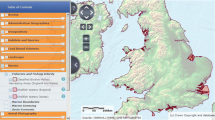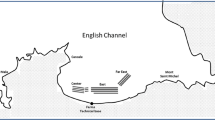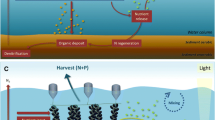Abstract
The occurrence and composition of toxic algae, and presence of viruses and other human microbial pathogens in production areas of mussels are factors determining suitability of mussel products for human consumption. As bivalves feed by filtering large volumes of water, potentially toxic viruses, algae, and bacteria as well as phytoplankton are ingested. With the expansion of mussel aquaculture and subsequent increase in human consumption of mussel products, improved risk management is required for consumer protection. For example, shifting production to offshore areas (e.g. wind farms) can decrease the hazards of infection due to dilution of contaminants, and increase overall health of mussels. In addition, the deployment of off-bottom cultivation methods such as longlines increases the condition index, growth, and aesthetic appearance of mussels. However, other hazards like algal toxins not yet monitored on a regular basis, may play a more important rule offshore. Here, we present an analysis of biological, economic, and consumer health-related aspects of mussel cultivation under near- and offshore conditions.






Similar content being viewed by others
References
World Health Organisation and United Nations Environmental Programme (UNEP) (1987) Environmental quality criteria for shellfish-growing waters and shellfish in the Mediterranean. WHO/EURO document EUR/ICP/CEH 051. World Health Organization/Europe, Copenhagen
Lees D (2000) Viruses in bivalve shellfish. Int J Food Microbiol 59:81–116
Smaal A (2002) European mussel cultivation along the Atlantic coast: production status, problems and perspectives. Hydrobiologia 484:89–98
EC Regulation (EC) 854/2004. Regulation of the European Parliament and of the Council of 29 April 2004 laying down specific rules for the organization of official controls on products of animal origin intended for human consumption 139
le Guyader F, Haugarreau L, Miossec L, Dubois E, Pommepuy M (2000) Three-year study to assess human enteric viruses in shellfish. Appl Environ Microbiol 66:3241–3248
Formica-Cruz M, Tofino-Quesada G, Bofill-Mas S, Lees DN, Henshilwood K, Allard AK, Conden-Hansson A-C, Hernroth BE, Vantarakis A, Tsibouxi A, Papapetropoulou M, Furones MD, Girones R (2002) Distribution of human virus contamination in shellfish from different growing areas in Greece, Spain, Sweden and the United Kingdom. Appl Environ Microbiol 68:5990–5998
Croci L, De Medici D, Ciccozzi M, Di Pasquale S, Suffredini E, Toti L (2003) Contamination of mussels by hepatitis A virus: a public-health problem in southern Italy. Food control 14:559–563
Romalde JL, Area E, Sánchez G, Ribao C, Torrado I, Abad X, Pintó RM, Barja JL, Bosch A (2002) Prevalence of enterovirus and hepatitis A virus in bivalve molluscs from Galicia (NW Spain): inadequacy of the EU standards of microbiological quality. Int J Food Microbiol 74:119–130
CEFAS (2007) Microbiological monitoring of bivalve mollusc harvesting areas—guide to good practice: Technical application. European Community Reference Laboratory for monitoring bacteriological and viral contamination of bivalve mollusc. The centre of environment, fisheries and aquaculture science 3:67
Hernroth B (2003) Factors influencing bactericidal activity of blue mussel (Mytilus edulis) haemocytes against Salmonella typhimurium. Fish Shellfish Immunol 14:93–104
Shao ZJ (2001) Aquaculture pharmaceuticals and biologicals: current perspectives and future possibilities. Adv Drug Deliv Rev 50:229–243
Blake PA, Merson MH, Weaver RE, Hollis DG, Heublein PC (1979) Disease caused by a marine vibrio: clinical characteristics and epidemiology. N Engl J Med 300:1–5
Abad FX, Pinto RM, Gajardo R, Bosch A (1997) Viruses in mussels: public health implications and depuration. J Food Protect 60:677–681
Gantzer C, Dubois E, Crance JM, Billaudel S, Kopecka H, Schwartzbrod L, Pommepuy M, Le Guyader F (1998) Influence of environmental factors on the survival of enteric viruses in seawater. Acta Oceanol 21:983–992
Lipp EK, Rose JB (1997) The role of seafood in foodborne diseases in the United States of America. Rev Sci Technol 16:620–640
Salamina G, D′Argenio P (1998) Shellfish consumption and awareness of risk of acquiring hepatitis A among Neapolitan families—Italy, 1997. Euro Surveill 3:97–98
RKI-Bulletin (2000) Epidemiologisches Bulletin (ongoing). Robert Koch Institute, Berlin, Germany. http://www.rki.de/DE/Content/Infekt/EpidBull/epid_bull_node.html, assessed January 2009
CDC (1997) Results of the public health response to Pfiesteria-Workshop—Atlanta, Georgia, September 29–30, 1997. Morb Mortal Wkly Rep 46(40):951–952
CDR (1991) Paralytic shellfish poisoning. Communicable Dis Rep 1(22):1
Lehane L (2000) Paralytic Shellfish Poisoning: a review. National Office of Animal and Plant Health, Agriculture, Fisheries and Forestry. Canberra, Australia
Buck BH, Thieltges DW, Walter U, Nehls G, Rosenthal H (2005) Inshore–offshore comparison of parasite infestation in Mytilus edulis: implications for open ocean aquaculture. J Appl Ichthyol 21(2):107–113
Odlaug TO (1946) The effects of copepod Mytilicola orientalis upon the Olympia oyster Ostrea lurida. Trans Am Microsc Soc 65:311–317
Meyer PF, Mann H (1950) Beiträge zu Epidemiologie und Physiologie der parasitischen Copepoden Mytilicola intestinalis. Archiv für Fischereiwissenschaften 2:120–134
Cole A, Savage RE (1951) The effect of the parasitic copepod Mytilicola intestinalis (Steuer) upon the condition of mussels. Parasitology 41:156–161
Dethlefsen V (1975) The influence of Mytilicola intestinalis (Steuer) on the meat content of the mussel Mytilus edulis. Aquaculture 6:83–97
Kent RML (1981) The effect of Polydora ciliata on the shell strength of Mytilus edulis. J Int Council Exploration Sea 39:252–255
Kent RML (1979) The influence of heavy infestations of Polydora ciliata on the flesh content of Mytilus edulis. J Mar Biol Assoc UK 59:289–297
Taskinen J (1998) Influence of trematode parasitism on the growth of a bivalve host in the field. Int J Parasitol 28:599–602
Thieltges DW (2006) Effect of infection by the metacercarial trematodes Renicola roscovita on growth in the intertidal blue mussel Mytilus edulis. Mar Ecol Prog Ser 319:129–134
Davey JT, Gee JM (1988) Mytilicola intestinalis, a copepod parasite of blue mussels. American Fisheries Society, Special Publications 18:64–73
Le Roux F, Lorenzo G, Peyret P, Audemard C, Figueras A, Vivarès C, Gouy M, Berthe FCJ (2001) Molecular evidence for the existence of two species of Marteilia in Europe. J Eukaryot Microbiol 48(4):449–454
Grizel H, Comps M, Bonami JR, Cousserans F, Duthoit JL, Le Pennec MA (1974) Recherche sur l’agent de la maladie de la glande digestive de Ostrea edulis Linne. Bulletin de l’ Institute des Peches Maritimes 240:7–30
Cheng TC (1967) Marine molluscs as host for symbiosis. In: Russel FS (ed) Advances marine biology (5). Academic Press, London, p 424
Zens M (1999) Der Einfluss von Parasiten auf Vitalität und Bestandentwicklung der Miesmuschel (Mytilus edulis L.). Dienstbericht der Forschungsstelle Küste, Niedersächsisches Landesamt für Ökologie, 31
Laudien J, Wahl M (2004) Associational resistance of fouled blue mussels (Mytilus edulis) against starfish (Asterias rubens) predation: relative importance of structural and chemical properties of the epibionts. Helgol Mar Res 58:162–167
Buschbaum C, Saier B (2001) Growth of the mussel Mytilus edulis L. in the Wadden Sea affected by tidal emergence and barnacle epibionts. J Sea Res 45:27–36
Dittmann D, Robles C (1991) Effect of algae epiphytes on the mussel Mytilus californianus. Ecology 72(1):286–296
Buck BH (2007) Experimental trials on the feasibility of offshore seed production of the mussel Mytilus edulis in the German Bight: installation, technical requirements and environmental conditions. Helgol Mar Res 61:87–101
Buck BH, Krause G, Rosenthal H (2004) Multifunctional use, environmental regulations and the prospect of offshore co-management: potential for and constraints to extensive open ocean aquaculture development within wind farms in Germany. Ocean Coastal Manage 47:95–122
Buck BH (2002) Open Ocean Aquaculture und Offshore-Windparks: Eine Machbarkeitsstudie über die multifunktionale Nutzung von Offshore-Windparks und Offshore-Marikultur im Raum Nordsee. Reports on Polar and Marine Research, Bremerhaven 412: 252
Ernst W, Weigelt S, Rosenthal H; Hansen PD (1991) Testing bioconcentration of organic chemicals with the common mussel (Mytilus edulis). In: Nagel L, Loskill R (eds) Bioaccumulation in aquatic systems: contributions to the assessment. Proceeding of International Workshop, Berlin, 1990. VCH-Verlag, Weinheim, pp 99–131
Seed R (1968) Factors influencing shell shape in the mussel Mytilus edulis. J Mar Biol Assoc UK 48:561–584
Dethlefsen V (1970) On the parasitology of Mytilus edulis (L. 1758) International Council for the Exploration of the sea (ICES) C.M. 1970/K: 16, Hamburg, 11
Dethlefsen V (1972) Zur Parasitologie der Miesmuschel (Mytilus edulis L., 1758). Berichte der Deutschen wissenschaftlichen Kommission für Meeresforschung 22:344–371
Lauckner G (1983). Diseases of Mollusca: Bivalvia. In: Kinne O (ed) Diseases of marine animals. Introduction, Bivalvia to Scaphopoda. Biologische Anstalt Helgoland, Hamburg, Westholsteinische Verlagsdruckerei Boyens & Co., Heide, pp 477–961
Watermann B, Die I, Liebe S (1998). Krankheiten der Miesmuschel (Mytilus edulis) an der ostfriesischen Küste: VII. Tagung der Deutschen Sektion der European Association of Fish Pathologists (EAFP) - Krankheiten der Aquatischen Organismen. 23–25 September 1998, Schmallenberg-Grafschaft, pp 177–187
Lepitzki DAW, Scott ME, McLaughlin JD (1994) Influence of storage and examination methods on the recovery and size of metacercaria of Cerastoderma edule (L.) from commercial beds of the lower Thames estuary. Z Parasitenkd 56:1–11
Ifremer (2008) Standard Operating Procedures and Quality – Molluscs processing for diagnostics by histology. Institut Français de Recherche pour l’Exploitation de la Mer, 7 pp. http://www.ifremer.fr/crlmollusc/page_labo/SOPs, accessed January 2009
DIN (German Industry Norm) 10161. Estimation of aerobic microbial number using drop plating procedure. German Institute for Standardisation e.V., Berlin, Germany
CEFAS/CRL (2008) Generic Standard Operating Procedure. The Centre of Environment, Fisheries and Aquaculture Science. Weymouth Laboratory, Weymouth, UK
DIN (German Industry Norm) EN (European Norm) ISO (International Organisation of Standardisation) 6579 (2003) Microbiology of food and animal feeding stuffs - Horizontal method for the detection of Salmonella spp.. German Institute for Standardisation e.V., Berlin, Germany
DIN EN ISO (7937) Microbiology of edibles and food stuff–Horizontal Procedure to count Clostridia-Colony-Counting-Method. German Institute for Standardisation e.V, Berlin
ISO 21872. Microbiology of edibles and food stuff—horizontal procedure to detect potential enteropathogene Vibrio spp
Höhne M, Schreier E (2004) Detection and characterization of norovirus outbreaks in Germany: application of a one-tube RT–PCR using a fluorogenic real-time detection system. J Med Virol 72:312–319
Sassen K, Velleuer R, Feldhusen F, Stede M, Effkemann S, Graf K, Zander HD, Pohlenz F, Heyken F, Hagena W, Hanslik M (2005) Niedersächsische Ausführungshinweise für die Überwachungsbehörden zur Durchführung der Muschelhygieneüberwachung. Niedersächsisches Ministerium für den ländlichen Raum, Ernährung, Landwirtschaft und Verbraucherschutz, Hannover, Germany, 18
EC Regulation (EC) 853/2004. Regulation of the European Parliament and of the Council of 29 April 2004 laying down specific hygiene rules for food of animal origin, 61
EC Regulation (EC) 2074/2005. Commission regulation of 5 December 2005 laying down implementing measures for certain products under Regulation (EC) No 853/2004 of the European Parliament and of the Council and for the organisation of official controls under Regulation (EC) No 854/2004 of the European Parliament and of the Council and Regulation (EC) No 882/2004 of the European Parliament and of the Council, derogating from Regulation (EC) No 852/2004 of the European Parliament and of the Council and amending Regulations (EC) No 853/2004 and (EC) No 854/2004
Quilliam MA, Sim PG, McCulloch AW, McInnes AG (1989) High performance liquid chromatography of domoic acid, a marine neurotoxin, with application to shellfish and plankton. Int J Environ Anal Chem 36:139–154
Lawrence JF, Menard C (1991) Liquid chromatography determination of paralytic shellfish poisons in shellfish after pre-chromatographic oxidation. J Assoc Off Anal Chem 74:1006–1012
Krakau M, Thieltges DW, Reise K (2006) Native parasites adopt introduced bivalves of the North Sea. Biol Invasions 8:919–925
Calvo-Ugarteburu G, McQuaid CD (1998) Parasitism and invasive species: effects of digenetic trematodes on mussels. Mar Ecol Prog Ser 169:149–163
Lhafi SK (2006). Untersuchungen zum bakteriellen und viralen Kontaminationsstatus von Miesmuscheln (Mytilus edulis) deutscher Herkunft. Dissertation. Institut für Lebensmittelqualität und –sicherheit, Tierärztliche Hochschule Hannover, 137
Rehnstam-Holm A-S, Hernroth B (2005) Shellfish and public health: a Swedish perspective. Ambio 34(2):139–144
Ryan J (2005). Offshore aquaculture—do we need it, and why is it taking so long? International Salmon Farmers Association (Ireland). Expert workshop on sustainable aquaculture, DG JRC European Commission, Institute for Prospective Technological Studies, 17–18 January 2005, Seville, Spain
Buck BH (2004) Farming in a high energy environment: potentials and constraints of sustainable offshore aquaculture in the German Bight (North Sea). Dissertation. University of Bremen, Bremen, Germany, 258
Wattreport (2008) Nationalpark Wattenmeer – (k)ein Raum für ungestörte Natur? Berichte von Meer und Küste für Förderer und Freunde der Schutzstation Wattenmeer. http://schutzstation-wattenmeer.de, Assessed August 2008
OiE (2003) Manual of diagnostic tests for aquatic animals. World Organisation for Animal Health, 7 pp. http://www.oie.int/eng/normes/fmanual/A_index.htm, Accessed January 2009
ICES (2008) Report of the Working Group on Marine Shellfish Culture (WGMASC), 1–3 April 2008, Aberdeen, UK. ICES CM 2008/MCC:02: 71
Acknowledgments
The authors are grateful to the Water and Shipping Authority (WSA) of Bremerhaven and the Niedersachsen Port Authorities (NPorts), Wilhelmsahven, both Germany who generously allowed using the offshore test field in the Weser estuary near the lighthouse Roter Sand and the cargo bridge at the Jade estuary, respectively, for the mussel cultivation experiments in the years 2006 and 2007. Further, we would like to thank Mr. André de Leeuw, head of the Royal Frysks Mussel Company in Emmelsbüll-Horsbüll, Germany, who provided on-bottom cultivated mussels for comparison. This work was realised within the project FV 168 MytiFit financed by the Alfred Wegener Institute for Polar and Marine Research, Bremerhaven, Germany and the Ministry of Construction, Environment, Traffic and Europe of the Federal State of Bremen, Bremen, Germany.
Author information
Authors and Affiliations
Corresponding author
Rights and permissions
About this article
Cite this article
Brenner, M., Ramdohr, S., Effkemann, S. et al. Key parameters for the consumption suitability of offshore cultivated blue mussels (Mytilus edulis L.) in the German Bight. Eur Food Res Technol 230, 255–267 (2009). https://doi.org/10.1007/s00217-009-1159-0
Received:
Revised:
Accepted:
Published:
Issue Date:
DOI: https://doi.org/10.1007/s00217-009-1159-0




